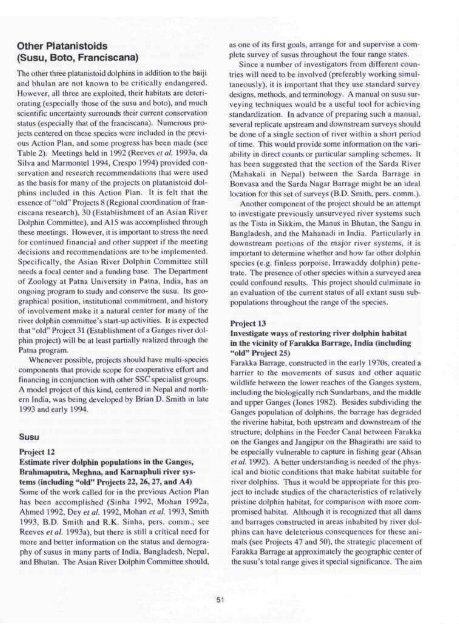Dolphins, Porpoises, and Whales - IUCN
Dolphins, Porpoises, and Whales - IUCN
Dolphins, Porpoises, and Whales - IUCN
Create successful ePaper yourself
Turn your PDF publications into a flip-book with our unique Google optimized e-Paper software.
Other Platanistoids<br />
(Susu, Boto, Franciscana)<br />
The other three platanistoid dolphins in addition to the baiji<br />
<strong>and</strong> bhulan are not known to be critically endangered.<br />
However, all three are exploited, their habitats are deteriorating<br />
(especially those of the susu <strong>and</strong> boto), <strong>and</strong> much<br />
scientific uncertainty surrounds their current conservation<br />
status (especially that of the franciscana). Numerous projects<br />
centered on these species were included in the previous<br />
Action Plan, <strong>and</strong> some progress has been made (see<br />
Table 2). Meetings held in 1992 (Reeves et al. 1993a, da<br />
Silva <strong>and</strong> Marmontel 1994, Crespo 1994) provided conservation<br />
<strong>and</strong> research recommendations that were used<br />
as the basis for many of the projects on platanistoid dolphins<br />
included in this Action Plan. It is felt that the<br />
essence of "old" Projects 8 (Regional coordination of franciscana<br />
research), 30 (Establishment of an Asian River<br />
Dolphin Committee), <strong>and</strong> A15 was accomplished through<br />
these meetings. However, it is important to stress the need<br />
for continued financial <strong>and</strong> other support if the meeting<br />
decisions <strong>and</strong> recommendations are to be implemented.<br />
Specifically, the Asian River Dolphin Committee still<br />
needs a focal center <strong>and</strong> a funding base. The Department<br />
of Zoology at Patna University in Patna, India, has an<br />
ongoing program to study <strong>and</strong> conserve the susu. Its geographical<br />
position, institutional commitment, <strong>and</strong> history<br />
of involvement make it a natural center for many of the<br />
river dolphin committee's start-up activities. It is expected<br />
that "old" Project 31 (Establishment of a Ganges river dolphin<br />
project) will be at least partially realized through the<br />
Patna program.<br />
Whenever possible, projects should have multi-species<br />
components that provide scope for cooperative effort <strong>and</strong><br />
financing in conjunction with other SSC specialist groups.<br />
A model project of this kind, centered in Nepal <strong>and</strong> northern<br />
India, was being developed by Brian D. Smith in late<br />
1993 <strong>and</strong> early 1994.<br />
Susu<br />
Project 12<br />
Estimate river dolphin populations in the Ganges,<br />
Brahmaputra, Meghna, <strong>and</strong> Karnaphuli river systems<br />
(including "old" Projects 22, 26,27, <strong>and</strong> A4)<br />
Some of the work called for in the previous Action Plan<br />
has been accomplished (Sinha 1992, Mohan 1992a,<br />
Ahmed 1992, Dey et al. 1992, Mohan et al. 1993, Smith<br />
1993, B.D. Smith <strong>and</strong> R.K. Sinha, pers. comm.; see<br />
Reeves et al. 1993a), but there is still a critical need for<br />
more <strong>and</strong> better information on the status <strong>and</strong> demography<br />
of susus in many parts of India, Bangladesh, Nepal,<br />
<strong>and</strong> Bhutan. The Asian River Dolphin Committee should.<br />
i1<br />
as one of its first goals, arrange for <strong>and</strong> supervise a complete<br />
survey of susus throughout the four range states.<br />
Since a number of investigators from different countries<br />
will need to be involved (preferably working simultaneously),<br />
it is important that they use st<strong>and</strong>ard survey<br />
designs, methods, <strong>and</strong> terminology. A manual on susu surveying<br />
techniques would be a useful tool for achieving<br />
st<strong>and</strong>ardization. In advance of preparing such a manual,<br />
several replicate upstream <strong>and</strong> downstream surveys should<br />
be done of a single section of river within a short period<br />
of time. This would provide some information on the variability<br />
in direct counts or particular sampling schemes. It<br />
has been suggested that the section of the Sarda River<br />
(Mahakali in Nepal) between the Sarda Barrage in<br />
Bonvasa <strong>and</strong> the Sarda Nagar Barrage might be an ideal<br />
location for this set of surveys (B.D. Smith, pers. comm.).<br />
Another component of the project should be an attempt<br />
to investigate previously unsurveyed river systems such<br />
as the Tista in Sikkim, the Manus in Bhutan, the Sangu in<br />
Bangladesh, <strong>and</strong> the Mahanadi in India. Particularly in<br />
downstream portions of the major river systems, it is<br />
important to determine whether <strong>and</strong> how far other dolphin<br />
species (e.g. finless porpoise, Irrawaddy dolphin) penetrate.<br />
The presence of other species within a surveyed area<br />
could confound results. This project should culminate in<br />
an evaluation of the current status of all extant susu subpopulations<br />
throughout the range of the species.<br />
Project 13<br />
Investigate ways of restoring river dolphin habitat<br />
in the vicinity of Farakka Barrage, India (including<br />
"old" Project 25)<br />
Farakka Barrage, constructed in the early 1970s, created a<br />
barrier to the movements of susus <strong>and</strong> other aquatic<br />
wildlife between the lower reaches of the Ganges system,<br />
including the biologically rich Sundarbans, <strong>and</strong> the middle<br />
<strong>and</strong> upper Ganges (Jones 1982). Besides subdividing the<br />
Ganges population of dolphins, the barrage has degraded<br />
the riverine habitat, both upstream <strong>and</strong> downstream of the<br />
structure; dolphins in the Feeder Canal between Farakka<br />
on the Ganges <strong>and</strong> Jangipur on the Bhagirathi are said to<br />
be especially vulnerable to capture in fishing gear (Ahsan<br />
etal. 1992). Abetter underst<strong>and</strong>ing is needed of the physical<br />
<strong>and</strong> biotic conditions that make habitat suitable for<br />
river dolphins. Thus it would be appropriate for this project<br />
to include studies of the characteristics of relatively<br />
pristine dolphin habitat, for comparison with more compromised<br />
habitat. Although it is recognized that all dams<br />
<strong>and</strong> barrages constructed in areas inhabited by river dolphins<br />
can have deleterious consequences for these animals<br />
(see Projects 47 <strong>and</strong> 50), the strategic placement of<br />
Farakka Barrage at approximately the geographic center of<br />
the susu's total range gives it special significance. The aim

















